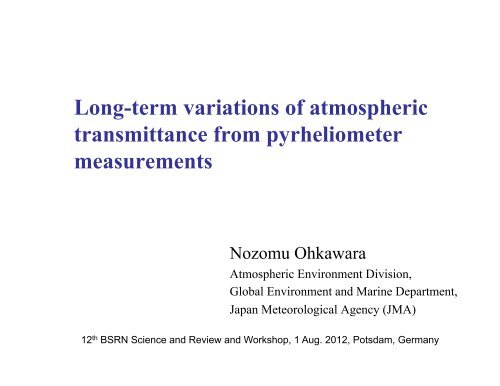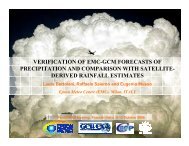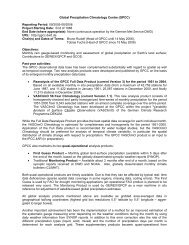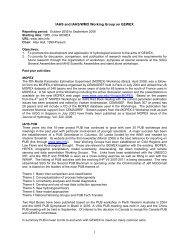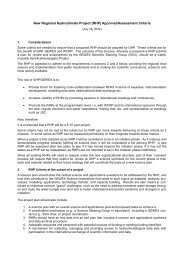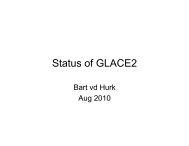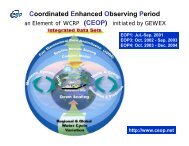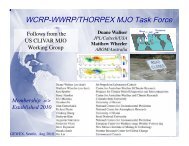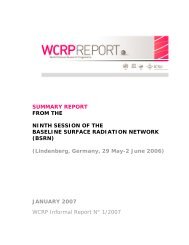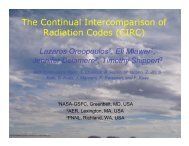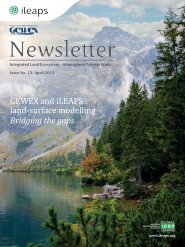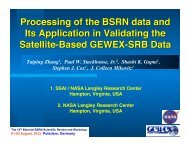Long-term variations of atmospheric transmittance from ... - GEWEX
Long-term variations of atmospheric transmittance from ... - GEWEX
Long-term variations of atmospheric transmittance from ... - GEWEX
Create successful ePaper yourself
Turn your PDF publications into a flip-book with our unique Google optimized e-Paper software.
<strong>Long</strong>-<strong>term</strong> <strong>variations</strong> <strong>of</strong> <strong>atmospheric</strong><br />
<strong>transmittance</strong> <strong>from</strong> pyrheliometer<br />
measurements<br />
Nozomu Ohkawara<br />
Atmospheric Environment Division,<br />
Global Environment and Marine Department,<br />
Japan Meteorological Agency (JMA)<br />
12 th BSRN Science and Review and Workshop, 1 Aug. 2012, Potsdam, Germany
Background<br />
• The long-<strong>term</strong> variation <strong>of</strong> the <strong>transmittance</strong> was reported for North<br />
America and for Europe<br />
• The long-<strong>term</strong> change in the <strong>transmittance</strong> measured over Japan is<br />
presented.<br />
• The weight <strong>of</strong> aerosol in de<strong>term</strong>ining the variation in <strong>transmittance</strong> is<br />
also analyzed.<br />
How was it<br />
change? <br />
Martin Wild, Hans Gilgen, Andreas Roesch, Atsumu Ohmura, Charles N. <strong>Long</strong>,<br />
Ellsworth G. Dutton, Bruce Forgan, Ain Kallis, Viivi Russak, Anatoly Tsvetkov (2005)
Direct solar radiation measurements in Japan<br />
• JMA has been conducting direct solar radiation measurements by<br />
pyrheliometers since International Polar Year (I.P.Y.) in 1932.<br />
• Although the number <strong>of</strong> observation stations differs by age, the<br />
measurements were conducted at 14 stations, which covered all<br />
climatic zones in Japan, for a long time.<br />
• The direct solar radiation was measured 3 times a day at 09, 12 and 15<br />
Local Apparent Time (LAT) when there was no cloud in the direction <strong>of</strong><br />
the sun.<br />
BSRN station <br />
A map <strong>of</strong> 14 stations <strong>of</strong> direct solar radiation measurement in Japan used in this study.
Station list used in this study (14 stations)<br />
Station <br />
WMO<br />
identifier <br />
Start <strong>of</strong><br />
observation <br />
Sapporo 47412 Aug.1932 - <br />
Nemuro 47420 Sep.1953 - <br />
Akita 47582 Aug.1932 - <br />
Miyako 47585 Jun.1952 - <br />
Wajima 47600 May 1953 - <br />
Matsumoto 47618 Jan. 1936 - <br />
Tateno 47646 Dec.1957 - <br />
Yonago 47744 Feb.1940 - <br />
Shionomisaki 47778 Aug.1932 - <br />
Fukuoka 47807 Aug.1932 - <br />
Kagoshima 47827 Apr.1940 - <br />
Shimizu 47898 Aug.1932 - <br />
Ishigakijima 47918 Jan.1941 - <br />
Naha 47936 Sep.1932 - <br />
BSRN station
Data rescue<br />
Recently, the results <strong>of</strong><br />
direct solar radiation<br />
measurements by<br />
pyrheliomaters were<br />
digitized, providing the<br />
basis for the study <strong>of</strong> long<strong>term</strong><br />
<strong>variations</strong> <strong>of</strong><br />
<strong>atmospheric</strong> <strong>transmittance</strong><br />
for more than 70 years. <br />
An original record <strong>of</strong> pyrheliometer measurements<br />
(at Fukuoka station in Aug. 1932)
Traceability to the international solar radiation scale<br />
Before 1970<br />
• Several Ångström pyrheliometers calibrated in Stockholm, Sweden<br />
were imported and used as national standard pyrheliometers.<br />
• Ångström scale 1905 was transfered to operational standard siver<br />
disk pyrheliometers, and then scale was converted to Smithsonian<br />
scale.<br />
Smithsonian scale (JMA) = Ångström scale 1905 x 1.035<br />
“The operational standard silver disk pyrheliometer used for<br />
calibration <strong>of</strong> operational pyrheliometers in early times was<br />
extremely stable and its sensitivity remained virtually unchanged<br />
for more than 35 years since the start <strong>of</strong> the observation in 1932”<br />
(Japan Meteorological Agency, 1975).
transfer the<br />
pyrheliometric scale<br />
Ångström pyrheliometer<br />
(national standard ) <br />
Silver disk pyrheliometer<br />
(operational standard & operational pyrheliometer)
1970-<br />
JMA has been participating IPC to calibrate national(regional)<br />
standard pyrheliometers against international scale since IPC-III in<br />
1970.<br />
IPC-III<br />
1970<br />
IPC-XI<br />
2010
Used pyrheliometer & scale <strong>of</strong> solar radiation measuremnents<br />
Period <br />
Type <strong>of</strong><br />
pyrheliometer <br />
Scale <strong>of</strong> solar radiation<br />
measurements <br />
Conversion factor to<br />
WRR <br />
1932- Silver disk<br />
pyrheliometer <br />
1957-1<br />
970 <br />
Silver disk<br />
pyrheliometer <br />
Smithsonian scale (JMA)<br />
(Ångström scale 1905 x1.035) <br />
1.026 / 1.035<br />
=0.9913 <br />
IPS-1956 (JMA)<br />
1.026 / (1.035x0.98)<br />
(Ångström scale 1905 x1.035x0.98) =1.012 <br />
1971-1<br />
977 <br />
1978-1<br />
980 <br />
Silver disk<br />
pyrheliometer <br />
Thermoelectric<br />
pyrheliometer <br />
1981- Thermoelectric<br />
pyrheliometer <br />
IPS-1956 <br />
IPS-1956 <br />
WRR <br />
1.022 <br />
1.022 <br />
1.000 <br />
All <strong>of</strong> the measurements were converted in WRR, before calculating<br />
the <strong>transmittance</strong>.<br />
As for the solar constant, a fixed value <strong>of</strong> 1367 W/m 2 recommended<br />
by World Meteorological Organization (WMO) was used.
Diurnal and seasonal variation <strong>of</strong> <strong>transmittance</strong><br />
Results<br />
annual <strong>variations</strong> <strong>of</strong> monthly mean <strong>transmittance</strong> averaged among selected 7 stations.<br />
Monthly mean <strong>transmittance</strong> values at each observation time (09, 12 and 15LAT) and<br />
diurnal mean values averaged over the whole data period <strong>from</strong> 1932 to 2005 are<br />
plotted.
• Diurnal <strong>variations</strong> between 09, 12 and 15LAT for each month are<br />
smaller than the range <strong>of</strong> the annual <strong>variations</strong> <strong>of</strong> monthly mean<br />
values.<br />
• The difference in the <strong>transmittance</strong> among each observation time<br />
within the same month is less than 0.02, while the difference between<br />
the largest and smallest months is much larger and reaches 0.13.<br />
• If a prolonged missing observations existed for several months, the<br />
seasonal <strong>variations</strong> could influence the annual means. This tendency<br />
must be taken into account for calculating the annual means.
<strong>Long</strong>-<strong>term</strong> <strong>variations</strong> <strong>of</strong> <strong>transmittance</strong><br />
Methods<br />
To analyze the long-<strong>term</strong> <strong>variations</strong> <strong>of</strong> <strong>atmospheric</strong> <strong>transmittance</strong>,<br />
the seasonal <strong>atmospheric</strong> <strong>transmittance</strong> was first calculated <strong>from</strong><br />
monthly mean for each year, so that each season has the same<br />
weight in the annual mean value.<br />
• spring: March-May<br />
• summer: June-August<br />
• fall: September-November<br />
• winter: January and November-December<br />
If there was any missing seasonal <strong>transmittance</strong> in a year, annual<br />
mean would not calculated.
Results<br />
• From 1933 to late 1940s, the <strong>transmittance</strong> remained stable at around<br />
0.74 to 0.75.<br />
• Decreasing phase followed to the mid-1980s when it reached 0.69.<br />
• It then turned into be increasing phase till the early 2000s marking the<br />
level <strong>of</strong> 0.71.<br />
<strong>Long</strong>-<strong>term</strong> <strong>variations</strong> <strong>of</strong> annual mean <strong>transmittance</strong> at 14 stations in Japan.<br />
A black thick line shows average among 14 stations.
Cause <strong>of</strong> long-<strong>term</strong> <strong>variations</strong> <strong>of</strong> <strong>transmittance</strong><br />
• Besides the large volcanic eruptions, the variation is caused<br />
mostly by the aerosol and the precipitable water vapor (PWV) in<br />
the atmosphere.<br />
• Japan has a dense coverage <strong>of</strong> the rawinsonde observation<br />
starting in 1955.<br />
• The impact on the long-<strong>term</strong> variation <strong>of</strong> <strong>transmittance</strong> by that <strong>of</strong><br />
water vapor content in the atmosphere was estimated using<br />
precipitable water vapor (PWV) <strong>from</strong> rawinsonde measurements.
Bias correction for rawinsonde measurements<br />
During the period <strong>from</strong> 1957 to 2005,<br />
three types <strong>of</strong> rawinsonde were used for<br />
upper air observation.<br />
The biases among them were reported as<br />
the intercomparison results, beforehand<br />
(Japan Meteorological Agency, 1983;<br />
World Meteorological Organization,<br />
1996). <br />
<br />
<br />
<br />
<br />
<br />
<br />
<br />
<br />
pressure <br />
humidity <br />
temperature
Monthly mean precipitable water vapor <strong>from</strong> rawinsonde data<br />
Monthly mean precipitable water vapor (PWV) was calculated <strong>from</strong><br />
rawinsonde measurements at 00 and 12 UTC.<br />
It was confirmed bias correction for rawinsonde data worked well. <br />
<br />
Annual mean precipitable water vapor calculated <strong>from</strong> rawinsonde<br />
measurements at Tateno station.
Calculation <strong>of</strong> <strong>transmittance</strong> due to water vapor<br />
Transmittance due to water vapor content in the atmosphere was<br />
calculated <strong>from</strong> monthly mean PWV at 09, 12 and 15LAT on 15th day <strong>of</strong><br />
each month by Gueymard’s method (1998).<br />
Then monthly mean and annual mean <strong>transmittance</strong> were calculated.
Results<br />
• The variability <strong>of</strong> annual mean PWV is about 5 mm around the long<strong>term</strong><br />
mean <strong>of</strong> 22.13mm on average among the stations during the<br />
period <strong>from</strong> 1957 to 2005.<br />
• The variation in PWV would cause the <strong>transmittance</strong> change <strong>of</strong><br />
only about 0.01. <br />
<strong>Long</strong>-<strong>term</strong> <strong>variations</strong> <strong>of</strong> annual mean precipitable water vapor (PWV), <strong>transmittance</strong><br />
due to PWV (Tw) and total zenith <strong>transmittance</strong> (T) averaged among 7 stations in<br />
Japan. PWV and Tw are plotted for the period <strong>from</strong> 1957 to 2005 while T is plotted<br />
for the whole analyzed period.
Results (cont.)<br />
• Main cause <strong>of</strong> the variation <strong>of</strong> <strong>transmittance</strong> is due to the direct<br />
effect by aerosols in the atmosphere.<br />
• Among all aerosols in the atmosphere, the contribution <strong>of</strong> natural<br />
sources to the variation <strong>of</strong> the total aerosol concentration is very<br />
small (Streets et al., 2009) leaving the possiblity to anthropogenic<br />
aerosols.
Summary<br />
• From 1933 to late 1940s, total <strong>transmittance</strong> remained stable<br />
at around 0.74 to 0.75, followed by the decreasing phase to<br />
the mid-1980s when it reached 0.69. It then turned into be<br />
increasing phase till the early 2000s marking the level <strong>of</strong><br />
0.71.<br />
• Both mean <strong>transmittance</strong> and its variable range are smaller<br />
than those in Europe.<br />
• The majority <strong>of</strong> these <strong>variations</strong> is caused by aerosol, and<br />
water vapor changes making only a minor contribution.<br />
• The aerosol changes are considered to be due to changes in<br />
anthropogenic sources.
Danke!!


